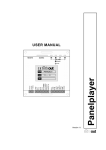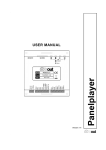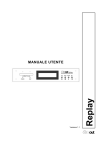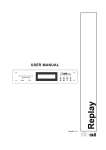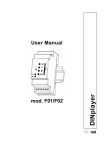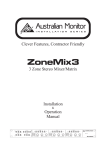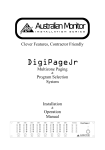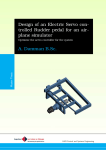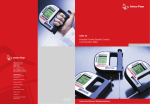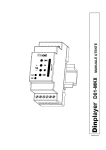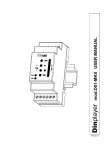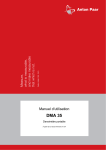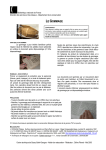Download AMIS-DMA1 manual.indd
Transcript
DMA1 D I GI TAL M E S S AGE AN N OU N CER INS TA LLAT I ON AN D OP E RAT I ON M AN UAL REMO T CONTR E OL SD/MM MEMOR C Y VOLUM ON PLAY Digita 2-24 DC IN E l Mess age A nnoun DMA1 cer LOGIC INP 1 2 3 UTS 4 5 6 7 8 PRE PRE IN OUT L R L R SPK OUT L R E I M P O RTA N T SAF E TY INF ORMATION 1. Save the carton and packing material even if the equipment has arrived in good condition. Should you ever need to ship the unit, use only the original factory packing. 2. Read all documentation before operating your equipment. Retain all documentation for future reference. 3. Follow all instructions printed on unit chassis for proper operation. 4. Do not spill water or other liquids into or on the unit, or operate the unit while standing in liquid. 5. Make sure power outlets conform to the power requirements listed on the back of the unit. 6. Do not use the unit if the electrical power cord is frayed or broken. The power supply cords should be routed so that they are not likely to be walked on or pinched by items placed upon or against them, paying particular attention to cords and plugs, convenience receptacles, and the point where they exit from the appliance. 7. 8. Always operate the unit with the AC ground wire connected to the electrical system ground. Precautions should be taken so that the means of grounding of a piece of equipment is not defeated. 13. Do not block fan intake or exhaust ports. Do not operate equipment on a surface or in an environment which may impede the normal flow of air around the unit, such as a bed, rug, weathersheet, carpet, or completely enclosed rack. If the unit is used in an extremely dusty or smoky environment, the unit should be periodically “blown free” of foreign matter. 14. Do not remove the cover. Removing the cover will expose you to potentially dangerous voltages. There are no user serviceable parts inside. 15. Do not drive the inputs with a signal level greater than that required to drive equipment to full output. 16. Do not connect the inputs / outputs of amplifiers or consoles to any other voltage source, such as a battery, mains source, or power supply, regardless of whether the amplifier or console is turned on or off. 17. Do not run the output of any amplifier channel back into another channel’s input. Do not parallel- or series-connect an amplifier output with any other amplifier output. Australian Monitor Inc is not responsible for damage to loudspeakers for any reason. 18. Do not ground any red (“hot”) terminal. Never connect a “hot” (red) output to ground or to another “hot” (red) output! Mains voltage must be correct and the same as that printed on the rear of the unit. Damage caused by connection to improper AC voltage is not covered by any warranty. 19. Non-use periods. The power cord of equipment should be unplugged from the outlet when left unused for a long period of time. 9. Have gain controls on amplifiers turned down during power-up to prevent speaker damage if there are high signal levels at the inputs. 20. Service Information Equipment should be serviced by qualified service personnel when: 10 Power down & disconnect units from mains voltage before making connections. A. The power supply cord or the plug has been damaged. B. Objects have fallen, or liquid has been spilled into the equipment 11. Never hold a power switch in the “ON” position if it won’t stay there itself! C. The equipment has been exposed to rain 12. Do not use the unit near stoves, heat registers, radiators, or other heat producing devices. D. The equipment does not appear to operate normally, or exhibits a marked change in performance E. The equipment has been dropped, or the enclosure damaged. THIS SAFETY INFORMATION IS OF A GENERAL NATURE AND MAY BE SUPERSEDED BY INSTRUCTIONS CONTAINED WITHIN THIS MANUAL This symbol is intended to alert the user to the presence of uninsulated “dangerous voltage” within the products enclosure that may be of sufficient magnitude to constitute a risk of electric shock to persons. CAUTION RISK OF ELECTRIC SHOCK DO NOT OPEN CAUTION: TO REDUCE THE RISK OF ELECTRIC SHOCK, This symbol is intended to alert the user to the presence of important operational and maintenance (servicing) instructions in the literature accompanying the appliance. DO NOT REMOVE COVER (OR BACK), NO USER SERVICEABLE PARTS INSIDE, REFER SERVICING TO QUALIFIED SERVICE PERSONAL. Caution: WARNING! TO REDUCE THE RISK OF FIRE OR ELECTRIC HOCK DO NOT EXPOSE THIS EQUIPMENT TO RAIN OR MOISTURE. To prevent electric shock do not use this (polarised) plug with an extension cord, receptacle or other outlet unless the blades can be fully inserted to prevent blade exposure. To prevent electric shock, match wide blade of plug to wide slot, fully insert. INTRODUCTION AND CONTENTS 1. INTRODUCTION 1.1 1.2 1.3 1.4 1.5 1.6 1.7 4 6.1 6.2 6.3 Introduction What is MP3? Encoder Decoder Player Wave Audio compression in various formats 2. INSTALLATION 2.1 2.2 4. Contents of the DMA1 kit Notices 6 Command description Connection description Power supply Logic inputs IN/OUT 8 - Vlink input/output Serial RS485 connection Line level audio input Line level audio output Amplified audio output 5.1 5.2 5.3 5.4 7.1 7.2 8. Introduction to playlist mode operation What is a playlist file? Playlist activation by logic inputs - MPLL (Mode PLayList) parameter Stop & Play Priority Playlist Priority Playlist Stop & Play Standard Playlist Standard Playlist Stop & Play Restart Playlist Restart Playlist 9. 9 15 Introduction to timed operation The palimpsest file – palin.txt Mixer function AVC function – automatic control of the output volume 20 Logic input operating mode Binary input command codes SPECIAL FUNCTIONS 8.1 8.2 What is the configuration file? Content of the configuration file How it is managed by the DMA1 Preparing the file Storing files in Flash memory Audio adjustment parameters Timing and switchover parameters Diagram of operating parameters Input management parameters Infrared movement sensor management parameters 5. SCHEDULED OPERATION 17 7. OPERATION WITH LOGIC INPUTS CONFIGURATION FILE 4.1 4.2 4.3 4.4 4.5 4.6 4.7 4.8 4.9 4.10 6.4 6.5 6.6 6.7 6.8 6.9 5 3. DESCRIPTION AND CONNECTIONS 3.1 3.2 3.3 3.4 3.5 3.6 3.7 3.8 3.9 6. PLAYLIST OPERATION 26 Connection of two DMA1s Amplifier bridging (40W) RS485 SERIAL COMMUNICATION 9.1 9.2 9.3 9.4 9.5 9.6 9.7 9.8 9.9 9.10 9.11 9.12 9.13 9.14 9.15 9.16 9.17 28 RS485 communication Serial port communication parameters (config.txt) Framing error NAK reply by a DMA1 Transmitting a command from a control system Basic format of dedicated protocols Basic set-up of data packets Control codes Address (ADD) Command (CMD) CheckSum (CHK) Basic protocol Basic protocol with CheckSum Basic protocol with CR and LF Basic protocol with CheckSum, CR and LF List of commands Error codes 10. SPECIFICATIONS 40 10.1 Technical features 10.2 Maintenance and conservation 10.3 Disposal AUS, EUR, USA Copyright 9th Feb 2006 Rev A: 1/03/06 A M I S - D M A 1 I N S TA L L AT I O N & O P E R AT I O N M A N U A L PA G E 3 INTRODUCTION 1.1 Introduction 1.4 Decoder The Australian Monitor Installation Series DMA-1 digital message announcer is a compact yet highly featured digital playback device. Utilizing an SD card digital storage format the DMA1 delivers high quality stereo audio in an MP3 format. Messages can be played or triggered using the on-board controls, via remote switches, contact closure or via RS485 serial control. The DMA-1 also boasts an on board 20 watt per channel D class power amplifier as well as stereo inputs & outputs which allow it to be inserted in line with another BGM feed. Software which decompresses an MP3 audio file in order to send it to a digital-analog converter and reconstruct the original audio signal. The DMA-1’s compact size belies the wealth of features it offers. It is a highly innovative & cost effective digital message storage & playback device that has a host of commercial applications. High quality audio format (extension .wav), compatible with the tracks of normal music CD’s. CD quality music utilises a sample rate of 44.1 KHz/sec. at 16 bit in stereo, but the size of the file is approximately about 10Mb per minute. 1.5 Player Hardware and software system able to read MP3 audio files. The DMA1 is able to carry out this function. 1.6 Wave 1.2 What is MP3? MP3 is an acronym for Mpeg-1 layer 3. This is an audio compression standard which eliminates sounds which the human ear cannot hear via a psycho-acoustic algorithm. The purpose of this compression is to reduce the space taken up by an audio file while still ensuring excellent quality. The greater the compression, the less the audio quality. The right compromise, which guarantees a quality comparable to that of a Compact Disc, is 128 Kbps (thousands of bits per second) which represents the most widely used manner, and reduces the size of an uncompressed file by 10 times. 1.7 Audio compression in various formats The following graphic shows the space taken up by an uncompressed audio file of about 5 minutes (.wav) and compressed in MP3 at 128Kbps (MP3). WAVE MP3 1.3 Encoder 51.1MB 4.6MB Software which compresses a CD audio or wave file in MP3. There are many programmes of this kind, and it is virtually impossible to say which is the best. Freeware software encoders suitable for various operating systems can be downloaded from the following internet site: www.mp3server.4t.com PA G E 4 A M I S - D M A 1 I N S TA L L AT I O N & O P E R AT I O N M A N U A L I N S TA L L AT I O N 2.1 Contents of the DMA1 kit 2.2 Notices 1x DMA1 device 1. The DMA1 has been designed to work only with the following mains power supply adaptors: 12-15VAC, 12-24VDC. 2. The device must be serviced only by qualified staff. 3. In order to prevent the risk of fire or shock do not put objects inside the device through openings 4. Disconnect the device from power before cleaning. Clean the device using a soft, dry cloth. Do not use liquids or sprays which contain flammable substances. 1x DMA1 user manual 1x 240VAC mains power adaptor 1x 128MB flash memory A M I S - D M A 1 I N S TA L L AT I O N & O P E R AT I O N M A N U A L PA G E 5 DESCRIPTION AND CONNECTIONS 3.1 Command description 1 Connector for external connection of memory and command buttons 2 Flash memory slot for Secure Digital or MultiMedia Card 3 Command keys: = (brief pressure) previous MP3 file / (prolonged pressure) reduce output volume = STOP = PLAY = (brief pressure) next MP3 file / (prolonged pressure) increase output volume 4 Red LED: 5 Green LED: lit = device is on lit = MP3 file playing; blinking = DMA1 in pause/STOP. IMPORTANT! • • Volume control via the keys is only possible during the playing of an MP3 audio file Pressing STOP during playing causes the DMA1 to pause, until reactivation with the PLAY key. This condition is indicated by the blinking green LED 1 2 REMOTE CONTROL 3 4 SD/MMC MEMORY 5 VOLUME ON PLAY Digital Message Announcer DMA1 12-24 VDC IN E 6 PA G E 6 LOGIC INPUTS 1 2 3 4 5 6 7 8 7 PRE PRE SPK IN OUT OUT L R L R L R 8 9 10 A M I S - D M A 1 I N S TA L L AT I O N & O P E R AT I O N M A N U A L DESCRIPTION AND CONNECTIONS 3.2 Connection description 6 VAC/DC Power input 12-15VAC or 12-24VDC 6 +12VDC Auxiliary + 12Vdc voltage, available for input activation or external feed sensors. MAX. 100mA 7 GND Ground for input activation using external contacts; auxiliary ground voltage 7 IN1 Multi-function input for activating 1.mp3 file or 1.m3u playlist (direct or bit 0 in binary combination) 8 IN L Line level audio input (left channel), for connection of external music sources (SAT, CD, Tuner etc) to be mixed with DMA1 generated audio 8 GND Ground signal of line level audio input 8 IN R Line level audio input (right channel), for connection of external music sources (SAT, CD, Tuner etc) to be mixed with DMA1 generated audio 9 OUT L Line level audio output (left channel) 7 IN2 Multi-function input for activating 2.mp3 file or .m3u playlist (direct or bit 1 in binary combination) 9 GND Ground signal of line level audio output 9 OUT R Line level audio output (right channel) 7 IN3 Multi-function input for activating 4.mp3 file or 3.m3u playlist (direct or bit 2 in binary combination) 10 SPK L Amplified audio output for speaker (20W), left channel 7 IN4 Multi-function input for activating 8.mp3 file or 4.m3u playlist (direct or bit 3 in binary combination) 10 GND Ground signal of amplified audio output 10 7 IN5/485A Multi-function input for activating 16.mp3 file or 5.m3u playlist (direct or bit 4 in binary combination) configurable for serial RS485 communication (see chap. 9) SPK R Amplified audio output for speaker (20W), right channel 7 IN6/485B Multi-function input for activating 32.mp3 file or 6.m3u playlist (direct or bit 5 in binary combination). Configurable for serial RS485 communication (see chap. 9) 7 IN/OUT7 Multi-function input/output for activating 64.mp3 file or 7.m3u playlist (direct or bit 6 in binary combination) 7 IN/OUT8 Multi-function input/output for activating 128.mp3 file (direct or bit 7 in binary combination) Configurable for external applications. 0=in standby, 1=in play (+12V). Permits two DMA1s to be connected in cascade for the synchronised management of music playlists and commercials spots (spot announcements) in a scheduled time frame (connection Vlink, par. 8.1) A M I S - D M A 1 I N S TA L L AT I O N & O P E R AT I O N M A N U A L PA G E 7 DESCRIPTION AND CONNECTIONS 3.3 Power supply 3.6 Serial RS485 connection The DMA1 may operate with the following main power adaptors: 1215VAC, 12-24VDC. It is recommended to use the mains adaptor supplied with the device. The red POWER LED lights up when power is present. The DMA1 can be connected to an RS485 bus that can be controlled by a Crestron control system, or any other RS485 enabled control system. To enable RS485 control, (pin IN5/485A and IN6/485B), remove the cover of the DMA1 and move the relative jumpers (see para. 9.1). 3.4 Logic inputs 3.7 Line level audio input The DMA1 has eight multi-function logic inputs to control the playing of the either playlists or individual audio files. Line level audio input (stereo) allowing the connection of an external music source (SAT, CD, Tuner, second DMA1 etc) that is mixed with DMA1 generated audio. This functionality allows the mixing of a music source with scheduled commercials or spot announcements. The pins are: 1GND 2IN 1 3IN 4IN 3 5IN 4 6IN 5 7IN 6 8IN 7 9IN 8 3.8 Line level audio output Line level audio output (stereo) on extractable terminal strip. 3.9 Amplified audio output In order to activate the playing of a file, connect the desired logic input pin to GND (or the desired logic input pins when operating in binary logic). 3.5 IN/OUT 8 - input/output Vlink Programmable logic input/output to connect two DMA1s in cascade, for synchronised management of music playlists with commercials/spots at scheduled intervals without interruptions. Vlink: 0 = in standby 1 = in play (+12V) PA G E 8 Amplified stereo audio output (20W + 20W) for the connection of external speakers. Connect external 4/8Ω speakers to the SPK L/GND and SPK R/GND terminal strip. It is recommended to cable the DMA1 far from power cables. The two cables that connect the speaker with the DMA1 amplified audio output terminals can be a potential source of interference. A M I S - D M A 1 I N S TA L L AT I O N & O P E R AT I O N M A N U A L C O N F I G U R AT I O N F I L E 4.1 What is the configuration file? 4.3 How it is managed by the DMA1 The DMA1 is a very versatile device which can be adapted to the needs of the application in which it is used. Different applications may require adjustment of volume, tone, loudness, communication parameters and timing. The configuration file stored in the main directory of the flash memory, together with the audio files, makes it possible to programme the various parameters of the DMA1. At the time the DMA1 is turned on, or when the flash memory card is inserted, the DMA1 will start to read the main directory of the flash memory. If the file config.txt is found, the DMA1 will store the configuration parameters into its own internal non-volatile memory. The parameters therefore stay in the internal memory of the DMA1 even after the device has been turned off or the flash memory card removed. It is therefore not mandatory for the configuration file to always be present on the flash memory card. Once all the parameters have been read and stored to the DMA1, the config.txt file can be deleted. This file must be assigned the name config.txt (this extension has been used so it can be modified by any text editor, including PocketPC text editors). 4.2 Content of the configuration file Each line of the configuration file consists of: • Mnemonic code of the parameter to be set. It always consists of our CAPITAL alphanumeric characters, and must always be at the beginning of the line. No more than one parameter is permitted on the same line • Separating ‘=’ character. This MUST be inserted just after the mnemonic code, without any spacing or tab characters • The relevant numerical parameter expressed as a decimal, to be inserted directly after the separation character, without any spacing or tab characters Example: LMP3=14 LOUT=14 LLIN=14 LLI2=5 LLOU=10 LTRE=10 LBAS=10 MOMD=0 NOTE: If it is necessary to configure multiple DMA1s with the same configuration parameters, a single flash memory card with the appropriate config.txt file can be prepared and sequentially insert this memory card into all the DMA1s to be configured. The final flash memory cards to be inserted into each DMA1 now only need to contain the MP3 audio files. 4.4 Preparing the file Any ordinary text editor (like Windows Notebook) can be used to create the config.txt file. The file must be saved as a pure text file (.txt). Should other programmes be used (e.g. Microsoft Word) be careful to save the document as “text only”: otherwise control characters would be inserted which would make it impossible for the DMA1 to interpret the file. 4.5 Storing files in flash memory The configuration file and all the MP3 audio files can be stored to the flash memory card via a special USB reader/writer for PC. A M I S - D M A 1 I N S TA L L AT I O N & O P E R AT I O N M A N U A L PA G E 9 C O N F I G U R AT I O N F I L E 4.6 Audio adjustment parameters The DMA1 allows for the following audio adjustments: • Independent adjustments of the MP3 file level, line level audio input volume and general amplified/line level output volume • Adjustment of loudness level • Separate adjustment of bass and treble tone control • Adjusting the level of the background music while delivering commercials/spot announcements • Activation/deactivation of power amplifier muting mode The following tables show the relation between the value set in the configuration file and the actual value of the audio parameter. MNEMONIC DESCRIPTION LMP3 MP3 decoder output level (value between 0 and 20 in decimal) LOUT Main audio output volume (line level outputs and amplified audio outputs) (value between 0 and 20 in decimal) LLIN Line level input volume when no MP3 are playing (value between 0 and 20 in decimal) LLI2 Line level input volume during the playback of MP3 files (value between 0 and 20 in decimal) LLOU Loudness level (value between 0 and 20 in decimal) LTRE Treble tone control (value between 0 and 20 in decimal) LBAS Bass tone control (value between 0 and 20 in decimal) MOMD Power amplifier muting mode (0=OFF/1=ON ). LMP3 (MP3 DECODER OUTPUT LEVEL) VALUE 0 1 2 3 LEVEL OFF 2% 5% 9% 4 5 6 14% 20% 26% 7 8 9 10 33% 40% 48% 56% 11 12 66% 77% 13 14 15 16 17 18 19 20 88% 100% 112% 128% 144% 161% 178% 200% 0dB +6dB LOUT (MAIN AUDIO OUTPUT VOLUME FOR LINE LEVEL AND AMPLIFIED AUDIO OUTPUTS) VALUE 0 LEVEL OFF 1 2 3 4 5 6 7 8 9 10 11 12 13 14 15 16 17 18 19 20 -55 dB -35 dB -28 dB -23 dB -20 dB -17 dB -14 dB -12 dB -10 dB -8 dB -6 dB -4 dB -2 dB 0 dB +2 dB +4 dB +6 dB +8 dB +10 dB +12 dB LLIN (INL/INR VOLUME WHEN NO MP3 IS PLAYING) VALUE 0 LEVEL OFF 1 2 3 4 5 6 7 8 9 10 11 12 13 14 15 16 17 18 19 20 -55 dB -35 dB -28 dB -23 dB -20 dB -17 dB -14 dB -12 dB -10 dB -8 B dB -6 dB -4 dB -2 dB 0 dB +2 dB +4 dB +6 dB +8 dB +10 dB +12 dB LLI2 (INL/INR VOLUME DURING THE PLAYBACK OF MP3 FILES (BACKGROUND MUSIC)) VALUE 0 LEVEL OFF 1 2 3 4 5 6 7 8 9 10 11 12 13 14 15 16 17 18 19 20 -55 dB -35 dB -28 dB -23 dB -20 dB -17 dB -14 dB -12 dB -10 dB -8 dB -6 dB -4 dB -2 dB 0 dB +2 dB +4 dB +6 dB +8 dB +10 dB +12 dB 20 LLOU (LOUDNESS LEVEL) VALUE 0 1 2 3 4 5 6 7 8 9 10 11 12 13 14 15 16 17 18 19 LEVEL 0 dB +0,5 dB +1 dB +1,5 dB +2 dB +2,5 dB +3 dB +4 dB +5 dB +6 dB +7 dB +8 dB +9 dB + 10 dB +11 dB + 12 dB + 13 dB + 14 dB + 15 dB + 16 + 17 dB dB LTRE (TREBLE TONE CONTROL) VALUE 0 1 2 3 4 5 6 7 8 9 10 11 12 13 14 15 16 17 18 19 20 LEVEL -12 dB -10 dB -8 dB -7 dB -6 dB -5 dB -4 dB -3 dB -2 dB -1 dB 0 dB +1 dB +2 dB +3 dB +4 dB +5 dB +6 dB +7 dB +8B dB +10 dB +12 dB PA G E 1 0 A M I S - D M A 1 I N S TA L L AT I O N & O P E R AT I O N M A N U A L C O N F I G U R AT I O N F I L E LBAS (BASS TONE CONTROL) VALUE 0 1 2 3 4 5 6 7 8 9 10 11 12 13 14 15 16 17 18 19 20 LEVEL -12 dB -10 dB -8 dB -7 dB -6 dB -5 dB -4 dB -3 dB -2 dB -1 dB 0 dB +1 dB +2 dB +3 dB +4 dB +5 dB +6 dB +7 dB +8 dB +10 dB +12 dB MOMD (MODE OUTPUT MUTING DISABLE) MOMD 1 = Muting Deactivated (Internal Power Amplifier Always Active) 0 = Muting Active (Internal Power Amplifier Is Only Active During The Playing Of The Mp3 Files) 4.7 Timing and switchover parameters The fade times, reaction time of the automatic output volume control and the delay time for starting the commercial/spot announcement at the end of the piece of music, can be modified with the following configuration parameters. Example: TFOU=15 TFIN=15 TAVC=3 TADU=15 MNEMONIC DESCRIPTION OF TIMING PARAMETER TFOU Setting the Fade-Out time in 1/10 of one second (value between 1 and 30 in decimal) TFIN Setting the Fade-In time in 1/10 of one second (value between 1 and 30 in decimal) TAVC Setting the reaction time of the automatic output volume control TADU Setting the delay time of the commercial/spot in 1/10 of one second (when two DMA1s are operating in cascade) (value between 0 and 20 in decimal) TFOU (FADE OUT TIME): SETTING THE FADE OUT TIME OF THE INL/INR AUDIO INPUT BEFORE PLAYING THE MP3 FILE VALUE TIME 1 2...4 1/10 second 5 6...9 ½ second 10 11...14 1 second 15 16...19 1,5 seconds 20 21...24 2 seconds 25 26...29 2,5 second 30 3 second TFIN (FADE IN TIME): SETTING THE FADE IN TIME OF THE INR/INL AUDIO INPUT AFTER PLAYING THE MP3 FILE VALUE TIME 1 2...4 1/10 second 5 6...9 ½ second 10 11...14 1 second 15 16...19 1,5 seconds 20 21...24 2 seconds 25 26...29 2,5 seconds 30 3 seconds TAVC: SETTING THE REACTION TIME OF THE AUTOMATIC OUTPUT VOLUME CONTROL VALUE TIME 0 1 2 3 4 OFF 2/10 seconds 2 seconds 4 seconds 8 seconds TADU: SETTING THE DELAY TIME OF THE PLAYING A COMMERCIAL/SPOT IN 1/10 SECOND (TWO DMA1S IN CASCADE) VALUE TIME 1 1/10 second 2...4 5 ½ second 6...9 10 1 second 11...14 15 16...19 1,5 seconds A M I S - D M A 1 I N S TA L L AT I O N & O P E R AT I O N M A N U A L 20 2 seconds 21...24 25 2,5 seconds 26...29 30 3 seconds PA G E 1 1 C O N F I G U R AT I O N F I L E 4.8 Diagram of operating parameters PA G E 1 2 A M I S - D M A 1 I N S TA L L AT I O N & O P E R AT I O N M A N U A L C O N F I G U R AT I O N F I L E 4.9 Input management parameters The playing of MP3 files takes place by activating the logic inputs. The activation modes are set through the IMOD, TPCM MICP and MIRS parameters inserted in the configuration file. Example: IMOD=0 TPCM=10 MICP=1 MIRS=0 MNEMONIC DESCRIPTION OF TIMING PARAMETER IMOD Setting the mode of the logic inputs as either active high or active low TPCM Setting the persistence time of the input command (time to wait before the DMA1 interprets the input command) expressed in decimals of milliseconds (value between 0 and 255 in decimal). MICP Setting Mode Input Continuous Play MIRS Setting Mode Input ReStart IMOD (INPUT MANAGEMENT MODE) IMOD 0 = active-low input mode; the logic input is active when connected to the ground/GND of the device 1 = active-high input mode; the logic input is active when connected to a positive voltage between 5 and 12VDC TPCM (TIME PERSISTENCE INPUT COMMAND MODE) TPCM 0 = no delay 100= 1 second 1 = 10mSeconds 200= 2 seconds 2 = 20mSeconds 250= 2.5 seconds MICP (MODE INPUT CONTINUOUS PLAY) MICP 0 = having terminated the playing of the MP3 file, the DMA1 goes into standby 1 = the requested MP3 file is continuously played until a new input code is entered MIRS (MODE INPUT RESTART) MIRS 0=repeated activation or deactivating of the same input code does not influence the playing of the relevant MP3 file. Only the activation of a different code can stop the playing of the current MP3 file and activate the playing of a new MP3 file 1=The relevant MP3 file commences playing from the beginning, even if the same MP3 is already in play A M I S - D M A 1 I N S TA L L AT I O N & O P E R AT I O N M A N U A L PA G E 1 3 C O N F I G U R AT I O N F I L E 4.10 Infrared movement sensor management parameters IMPORTANT: the following parameters are enabled exclusively for the IN1 input. Example: PYDT=1 PYDL=10 TAPL=0 RSPL=3 MNEMONIC DESCRIPTION PYDT Activation of IR sensor on IN1 logic input (0=OFF/1=ON ) PYDL Delay time between the completion of playing an MP3 file and the next IR sensor activation (value between 0 and 240 in decimal) TAPL Setting of the AUTOPLAY time for playing of a message when the IR sensor is not activated (value between 0 and 240 in decimal) RSPL Delay time between IR sensor movement detection and commencement of MP3 playback (value between 0 and 20 in decimal) PYDT (ACTIVATION INFRARED MOVEMENT SENSOR) 1 = IR sensor activated PYDT 0 = IR sensor deactivated PYDL (DELAY TIME BETWEEN END OF MP3 PLAYBACK AND IR SENSOR RE-ACTIVATION) VALUE 0 1 2 3 4 5 10 20 30 60 120 180 240 TIME IR 1 second 2 seconds 3 seconds 4 seconds 5 seconds 10 seconds 20 seconds 30 seconds 1 minute 2 minutes 3 minutes 4 minutes TAPL (SETTING AUTOPLAY TIME FOR PLAYING FILES WHEN THE IR SENSOR IS NOT ACTIVATED) VALUE TIME 0 1 NOT 10 managed seconds 2 3 4 5 6 12 18 30 60 180 240 20 seconds 30 seconds 40 seconds 50 seconds 1 second 2 seconds 3 seconds 5 minutes 10 minutes 30 minutes 40 minutes 20 21...24 25 26...49 50 RSPL (DELAY TIME BETWEEN IR MOVEMENT DETECTION AND START OF MP3 PLAYBACK) VALUE TIME 1 1/10 second PA G E 1 4 2...4 5 1/2 second 6...9 10 1 second 11...14 15 1,5 seconds 16...19 2 seconds 2,5 seconds 5 seconds A M I S - D M A 1 I N S TA L L AT I O N & O P E R AT I O N M A N U A L S C H E D U L E D O P E R AT I O N NOTE: It is very important to start a new line of text for each event, and to separate the hours from the minutes using the (:) character. 5.1 Introduction to timed operation When the flash memory card is inserted, the DMA1 will analyse its “ contents and – depending on the files which are present – will automatically set the mode of operation. In the presence of the PALIN.TXT file, the DMA1 plays the sequence of MP3 files in a cyclical emission (one hour cycles) called PALIMPSEST which are contained in the same PALIN.TXT file. 5.2 The palimpsest file – palin.txt The DMA1 can manage a list of MP3s to be played according to pre-set time intervals. This list is a simple text file (palin.txt) which contains a number of time events along with a sequence of MP3 files to be played for each specific time event. On the same line the names of the MP3 audio files to be used (and their sequence) must be defined (max. 8 characters). There are three different acceptable formats for separating multiple MP3 filenames for each event 1. Separating character [Tab] between one MP3 and the next: E.g.: 00:10 spot01 spot02 spot03 2. Comma (,) between one MP3 and the next: E.g.: 00:10,spot01,spot02,spot03 3. Semicolon (;) between one MP3 and the next: E.g.: 00:10;spot01;spot02;spot03 There are a few simple rules on how to set the palimpsest; firstly the time for an event must be defined in minutes. Eg: 00:10 Once the configuration has been completed, the file will appear similar to the following example: 00:00 00:05 00:10 00:15 00:20 00:25 00:30 00:35 00:40 00:45 00:50 00:55 SPOT04 SPOT09 SPOT11 SPOT01 SPOT12 SPOT16 SPOT09 SPOT05 SPOT02 SPOT04 SPOT02 SPOT09 SPOT07 SPOT17 SPOT02 SPOT08 SPOT03 SPOT17 SPOT10 SPOT11 SPOT11 SPOT07 SPOT11 SPOT11 SPOT03 SPOT06 SPOT05 SPOT12 SPOT13 SPOT14 EXAMPLE OF PALIN.TXT FILE WITH CYCLICAL EMISSION AT INTERVALS OF 5 MINUTES OF COMMERCIAL SPOTS An example of the reading and functioning of a timetable is provided below: 00:05 00:11 SPOT05 SPOT01 SPOT11 SPOT07 SPOT12 SPOT03 In this case the DMA1 remains in standby for 5 minutes from the moment it is turned on. At the 5th minute the DMA1 fades out the external line level audio input source in order to play the 00:05 time event, composed of 5 MP3 files. Once the time event has finished playing Spot05, Spot11, Spot12, Spot13 and Spot14, the DMA1 fades the external line level audio input back in. Upon reaching the 11th minute the DMA1 fades out the external line level audio input source and plays the 00:10 time event, composed of 3 MP3 files. A M I S - D M A 1 I N S TA L L AT I O N & O P E R AT I O N M A N U A L PA G E 1 5 S C H E D U L E D O P E R AT I O N IMPORTANT! When using the line level audio inputs, check the settings of the LLIN, LLI2 and MOMD parameters inserted in the configuration file (par. 4.6). Programming limits: Max. programming time permitted 1 hour (cyclic) Max. quantity of time events 60 events Max. quantity of MP3s per time event 8 MP3 files Max. quantity of MP3s per palimpsest 500 MP3 files 5.3 Mixer function The DMA1 has an audio input for connection to external music sources, with a mixer function to mix this source with the files played from flash memory (see par. 8.3). At the time scheduled for delivering each time event the DMA1 fades out the external audio source from the level LLIN to the PA G E 1 6 From 00:00 to 00:59 level LLI2, according to a programmed fade time TFOU. Then the sequence of MP3 files of the time event are played at LMP3 level, mixed with the external audio source with level LLI2. Once the time event has finished, the DMA1 brings the external audio source back to the level LLIN according to a programmed fade time TFIN. A M I S - D M A 1 I N S TA L L AT I O N & O P E R AT I O N M A N U A L P L AY L I S T O P E R AT I O N 6.1 Introduction to playlist mode operation When the flash memory is inserted, the DMA1 analyses its content to define its mode of operation based upon the files present: 1. 2. File: PLAYLIST.TXT plays audio files in sequence according to the list present in the file File: 1.M3U, 2.M3U, 3.M3U, 4.M3U, 5.M3U, 6.M3U, 7.M3U plays audio files in sequence according to the list present, activated by logic input IN1 = 1.m3u IN5 = 5.m3u IN2 = 2.m3u IN6 = 6.m3u IN3 = 3.m3u IN7 = 7.m3u IN4 = 4.m3u During play the four command buttons REW, STOP, PLAY and FWD are active. 6.2 What is a playlist file? The DMA1 is able to follow a sequence or list of audio files; this play list is a simple text file called playlist.txt which can be inserted in the main directory of the same memory containing the audio files. 6.3 Playlist activation by logic inputs - MPLL (Mode PLayList) parameter The seven available playlists activated by the logic inputs, can be played with different modes depending upon the varying needs. To choose between the different modes of operation the configuration parameter MPLL (Mode PLayList) must be defined in the config.txt file. When the flash memory card is inserted, the DMA1, depending on the setting of the parameter MPLL in the file config.txt, will switch over to the relevant mode of operation. IMPORTANT! • The names of the 7 playlists are fixed • The loading times of the Playlists may last even tens of seconds, during which the DMA1 is not able to play Follow a few, easy rules to set the sequence: Example with numbers: 1 3 7 9 5 01 005 Example with names: intro part 1 part 2 monologu music part 3 finale IMPORTANT! • Rename the MP3 audio files with numbers or names with 8 characters max. • Do not write in the extension (.mp3) • Max. 500 MP3 files per playlist Insert the flash memory card and wait for the DMA1 to read the playlist. At the end of the reading operation, if the names of the pieces have been fitted in correctly, the DMA1 will automatically start to play the MP3 files in the programmed sequence or wait the activation of a logic input. A M I S - D M A 1 I N S TA L L AT I O N & O P E R AT I O N M A N U A L PA G E 1 7 C O N F I G U R AT I O N F I L E 6.4 MPLL=10: Stop & Play Priority playlist Operating mode: • Upon activation of a logic input, the first MP3 in the playlist is played. At the end of the MP3 file the DMA1 goes in standby, awaiting further logic input activation. Activating the logic input once again, or if the logic input remains active, the next MP3 file in the playlist is played INPUTVALUE • Repeated activations or deactivations of the same logic input or of other inputs does not interrupt the playing of an MP3 file • The playlist is looped, as long as the relative logic input remains activated RELATIVE PLAYLISTV NONE = STANDBY IN 1 = 1.M3U Playlist 1.m3u IN 2 = 2.M3U Playlist 2.m3u IN 3 = 3.M3U Playlist 3.m3u IN 4 = 4.M3U Playlist 4.m3u IN 5 = 5.M3U Playlist 5.m3u IN 6 = 6.M3U Playlist 6.m3u IN 7 = 7.M3U Playlist 7.m3u IN 8 = VLINK FUNCTION NOTE: If several inputs are activated, the lowest playlist is activated. For example, if IN4 and IN5 are active, the playlist 4.m3u is played. PA G E 1 8 A M I S - D M A 1 I N S TA L L AT I O N & O P E R AT I O N M A N U A L P L AY L I S T O P E R AT I O N 6.5 MPLL=11: Priority playlist Operating mode: • Upon activation of a logic input, the MP3 files in the playlist are played in sequence. At the end of the playlist the DMA1 goes in standby, awaiting further logic input activation. Activating the logic input once again, or if the logic input remains active, the MP3 files in the playlist are played again • Repeated activations or deactivations of the same logic input or of other inputs does not interrupt the playing of an MP3 file • The playlist is looped, as long as the relative logic input remains activated 6.6 MPLL=12: Stop & Play Standard playlist Operating mode as MPLL=10 except: 6.8 MPLL=14: Stop & Play Restart playlist Operating mode as MPLL=10 except: • • Repeated activations or deactivations of the same logic input does not influence the playing of the current MP3 file. Only the activation of a different logic input stops the current MP3 being played and activates the first MP3 file in the new playlist. When the same logic input is reactivated the current MP3 file is restarted. The activation of a different logic input stops the current MP3 being played and activates the first MP3 file in the new playlist. 6.7 MPLL=13: Standard playlist Operating mode as MPLL=11 except: 6.9 MPLL=15 : Restart playlist Operating mode as MPLL=11 except: • • Repeated activations or deactivations of the same logic input does not influence the playing of the current playlist. Only the activation of a different logic input stops the current MP3 being played and activates the new playlist. When the same logic input is reactivated the playlist restarts from the beginning. The activation of a different logic input stops the current MP3 being played and activates the new playlist. A M I S - D M A 1 I N S TA L L AT I O N & O P E R AT I O N M A N U A L PA G E 1 9 O P E R AT I O N W I T H L O G I C I N P U T S 7.1 Logic input operating mode 7.2 Binary input command codes The DMA1 can also play individual MP3 audio files with direct selection from eight logic inputs (par. 3.4). The DMA1 enters this working mode if there are no PALIN.TXT and PLAYLIST.TXT files present. Activating the logic inputs in binary combination allows the playing of up to 255 messages, named according to the audio files as shown in the following table. Activation is carried out directly or in binary combination, up to a maximum of 255 files, using the logic inputs IN1, IN2, IN3, IN4, IN5, IN6, IN7 and IN8. The play modes are set through the IMOD, TPCM, MICP and MIRS parameters inserted in the configuration files (par. 4.7). 1 2 3 INPUT 4 5 RELEVANT FILES / MESSAGES 6 O O O O O O 1 O O O O O 7 8 = File.mp3 O O = Standby O O = 1.mp3 individual activation input IN1 O 1 O O O O O O = 2.mp3 individual activation input IN2 1 1 O O O O O O = 3.mp3 binary combination inputs IN1 + IN2 O O 1 O O O O O = 4.mp3 individual activation input IN3 1 O 1 O O O O O = 5.mp3 binary combination inputs IN1 + IN3 O 1 1 O O O O O = 6.mp3 binary combination inputs IN2 + IN3 1 1 1 O O O O O = 7.mp3 binary combination inputs IN1 + IN2 + IN3 O O O 1 O O O O = 8.mp3 individual activation input IN4 1 O O 1 O O O O = 9.mp3 binary combination inputs IN1 + IN4 O 1 O 1 O O O O = 10.mp3 binary combination inputs IN2 + IN4 1 1 O 1 O O O O = 11.mp3 binary combination inputs IN1 + IN2 + IN4 O O 1 1 O O O O = 12.mp3 binary combination inputs IN3 + IN4 1 O 1 1 O O O O = 13.mp3 binary combination inputs IN1 + IN3 + IN4 O 1 1 1 O O O O = 14.mp3 binary combination inputs IN2 + IN3 + IN4 1 1 1 1 O O O O = 15.mp3 binary combination inputs IN1 + IN2 + IN3 + IN4 O O O O 1 O O O = 16.mp3 individual activation input IN5 1 O O O 1 O O O = 17.mp3 O 1 O O 1 O O O = 18.mp3 1 1 O O 1 O O O = 19.mp3 O O 1 O 1 O O O = 20.mp3 1 O 1 O 1 O O O = 21.mp3 O 1 1 O 1 O O O = 22.mp3 23.mp3 1 1 1 O 1 O O O = O O O 1 1 O O O = 24.mp3 1 O O 1 1 O O O = 25.mp3 PA G E 2 0 A M I S - D M A 1 I N S TA L L AT I O N & O P E R AT I O N M A N U A L O P E R AT I O N W I T H L O G I C I N P U T S 1 2 3 INPUT 4 5 6 7 8 = File.mp3 RELEVANT FILES / MESSAGES O 1 O 1 1 O O O = 26.mp3 1 1 O 1 1 O O O = 27.mp3 O O 1 1 1 O O O = 28.mp3 1 O 1 1 1 O O O = 29.mp3 O 1 1 1 1 O O O = 30.mp3 1 1 1 1 1 O O O = 31.mp3 O O O O O 1 O O = 32.mp3 1 O O O O 1 O O = 33.mp3 O 1 O O O 1 O O = 34.mp3 1 1 O O O 1 O O = 35.mp3 O O 1 O O 1 O O = 36.mp3 1 O 1 O O 1 O O = 37.mp3 38.mp3 O 1 1 O O 1 O O = 1 1 1 O O 1 O O = 39.mp3 O O O 1 O 1 O O = 40.mp3 1 O O 1 O 1 O O = 41.mp3 O 1 O 1 O 1 O O = 42.mp3 1 1 O 1 O 1 O O = 43.mp3 O O 1 1 O 1 O O = 44.mp3 1 O 1 1 O 1 O O = 45.mp3 O 1 1 1 O 1 O O = 46.mp3 1 1 1 1 O 1 O O = 47.mp3 O O O O 1 1 O O = 48.mp3 1 O O O 1 1 O O = 49.mp3 50.mp3 O 1 O O 1 1 O O = 1 1 O O 1 1 O O = 51.mp3 O O 1 O 1 1 O O = 52.mp3 1 O 1 O 1 1 O O = 53.mp3 O 1 1 O 1 1 O O = 54.mp3 1 1 1 O 1 1 O O = 55.mp3 O O O 1 1 1 O O = 56.mp3 1 O O 1 1 1 O O = 57.mp3 O 1 O 1 1 1 O O = 58.mp3 1 1 O 1 1 1 O O = 59.mp3 O O 1 1 1 1 O O = 60.mp3 1 O 1 1 1 1 O O = 61.mp3 62.mp3 O 1 1 1 1 1 O O = 1 1 1 1 1 1 O O = 63.mp3 O O O O O O 1 O = 64.mp3 1 O O O O O 1 O = 65.mp3 O 1 O O O O 1 O = 66.mp3 1 1 O O O O 1 O = 67.mp3 O O 1 O O O 1 O = 68.mp3 1 O 1 O O O 1 O = 69.mp3 O 1 1 O O O 1 O = 70.mp3 1 1 1 O O O 1 O = 71.mp3 individual activation input IN6 individual activation input IN7 A M I S - D M A 1 I N S TA L L AT I O N & O P E R AT I O N M A N U A L PA G E 2 1 O P E R AT I O N W I T H L O G I C I N P U T S 1 2 3 INPUT 4 5 6 7 8 = File.mp3 RELEVANT FILES / MESSAGES O O O 1 O O 1 O = 72.mp3 1 O O 1 O O 1 O = 73.mp3 O 1 O 1 O O 1 O = 74.mp3 1 1 O 1 O O 1 O = 75.mp3 O O 1 1 O O 1 O = 76.mp3 1 O 1 1 O O 1 O = 77.mp3 O 1 1 1 O O 1 O = 78.mp3 1 1 1 1 O O 1 O = 79.mp3 O O O O 1 O 1 O = 80.mp3 1 O O O 1 O 1 O = 81.mp3 O 1 O O 1 O 1 O = 82.mp3 1 1 O O 1 O 1 O = 83.mp3 84.mp3 O O 1 O 1 O 1 O = 1 O 1 O 1 O 1 O = 85.mp3 O 1 1 O 1 O 1 O = 86.mp3 1 1 1 O 1 O 1 O = 87.mp3 O O O 1 1 O 1 O = 88.mp3 1 O O 1 1 O 1 O = 89.mp3 O 1 O 1 1 O 1 O = 90.mp3 1 1 O 1 1 O 1 O = 91.mp3 O O 1 1 1 O 1 O = 92.mp3 1 O 1 1 1 O 1 O = 93.mp3 O 1 1 1 1 O 1 O = 94.mp3 1 1 1 1 1 O 1 O = 95.mp3 96.mp3 O O O O O 1 1 O = 1 O O O O 1 1 O = 97.mp3 O 1 O O O 1 1 O = 98.mp3 1 1 O O O 1 1 O = 99.mp3 O O 1 O O 1 1 O = 100.mp3 1 O 1 O O 1 1 O = 101.mp3 O 1 1 O O 1 1 O = 102.mp3 1 1 1 O O 1 1 O = 103.mp3 O O O 1 O 1 1 O = 104.mp3 1 O O 1 O 1 1 O = 105.mp3 O 1 O 1 O 1 1 O = 106.mp3 1 1 O 1 O 1 1 O = 107.mp3 108.mp3 O O 1 1 O 1 1 O = 1 O 1 1 O 1 1 O = 109.mp3 O 1 1 1 O 1 1 O = 110.mp3 1 1 1 1 O 1 1 O = 111.mp3 O O O O 1 1 1 O = 112.mp3 1 O O O 1 1 1 O = 113.mp3 O 1 O O 1 1 1 O = 114.mp3 1 1 O O 1 1 1 O = 115.mp3 O O 1 O 1 1 1 O = 116.mp3 1 O 1 O 1 1 1 O = 117.mp3 PA G E 2 2 A M I S - D M A 1 I N S TA L L AT I O N & O P E R AT I O N M A N U A L O P E R AT I O N W I T H L O G I C I N P U T S 1 2 3 INPUT 4 5 6 7 8 = RELEVANT FILES / MESSAGES O 1 1 O 1 1 1 O = 118.mp3 1 1 1 O 1 1 1 O = 119.mp3 O O O 1 1 1 1 O = 120.mp3 1 O O 1 1 1 1 O = 121.mp3 O 1 O 1 1 1 1 O = 122.mp3 File.mp3 1 1 O 1 1 1 1 O = 123.mp3 O O 1 1 1 1 1 O = 124.mp3 1 O 1 1 1 1 1 O = 125.mp3 O 1 1 1 1 1 1 O = 126.mp3 1 1 1 1 1 1 1 O = 127.mp3 O O O O O O O 1 = 128.mp3 1 O O O O O O 1 = 129.mp3 O 1 O O O O O 1 = 130.mp3 1 1 O O O O O 1 = 131.mp3 O O 1 O O O O 1 = 132.mp3 1 O 1 O O O O 1 = 133.mp3 O 1 1 O O O O 1 = 134.mp3 1 1 1 O O O O 1 = 135.mp3 O O O 1 O O O 1 = 136.mp3 1 O O 1 O O O 1 = 137.mp3 O 1 O 1 O O O 1 = 138.mp3 1 1 O 1 O O O 1 = 139.mp3 O O 1 1 O O O 1 = 140.mp3 1 O 1 1 O O O 1 = 141.mp3 142.mp3 O 1 1 1 O O O 1 = 1 1 1 1 O O O 1 = 143.mp3 O O O O 1 O O 1 = 144.mp3 1 O O O 1 O O 1 = 145.mp3 O 1 O O 1 O O 1 = 146.mp3 1 1 O O 1 O O 1 = 147.mp3 O O 1 O 1 O O 1 = 148.mp3 1 O 1 O 1 O O 1 = 149.mp3 O 1 1 O 1 O O 1 = 150.mp3 1 1 1 O 1 O O 1 = 151.mp3 O O O 1 1 O O 1 = 152.mp3 1 O O 1 1 O O 1 = 153.mp3 154.mp3 O 1 O 1 1 O O 1 = 1 1 O 1 1 O O 1 = 155.mp3 O O 1 1 1 O O 1 = 156.mp3 1 O 1 1 1 O O 1 = 157.mp3 O 1 1 1 1 O O 1 = 158.mp3 1 1 1 1 1 O O 1 = 159.mp3 O O O O O 1 O 1 = 160.mp3 1 O O O O 1 O 1 = 161.mp3 O 1 O O O 1 O 1 = 162.mp3 1 1 O O O 1 O 1 = 163.mp3 individual activation input IN8 A M I S - D M A 1 I N S TA L L AT I O N & O P E R AT I O N M A N U A L PA G E 2 3 O P E R AT I O N W I T H L O G I C I N P U T S 1 2 3 INPUT 4 5 6 7 8 = RELEVANT FILES / MESSAGES O O 1 O O 1 O 1 = 164.mp3 1 O 1 O O 1 O 1 = 165.mp3 O 1 1 O O 1 O 1 = 166.mp3 File.mp3 1 1 1 O O 1 O 1 = 167.mp3 O O O 1 O 1 O 1 = 168.mp3 1 O O 1 O 1 O 1 = 169.mp3 O 1 O 1 O 1 O 1 = 170.mp3 1 1 O 1 O 1 O 1 = 171.mp3 O O 1 1 O 1 O 1 = 172.mp3 1 O 1 1 O 1 O 1 = 173.mp3 O 1 1 1 O 1 O 1 = 174.mp3 1 1 1 1 O 1 O 1 = 175.mp3 176.mp3 O O O O 1 1 O 1 = 1 O O O 1 1 O 1 = 177.mp3 O 1 O O 1 1 O 1 = 178.mp3 1 1 O O 1 1 O 1 = 179.mp3 O O 1 O 1 1 O 1 = 180.mp3 1 O 1 O 1 1 O 1 = 181.mp3 O 1 1 O 1 1 O 1 = 182.mp3 1 1 1 O 1 1 O 1 = 183.mp3 O O O 1 1 1 O 1 = 184.mp3 1 O O 1 1 1 O 1 = 185.mp3 O 1 O 1 1 1 O 1 = 186.mp3 1 1 O 1 1 1 O 1 = 187.mp3 188.mp3 O O 1 1 1 1 O 1 = 1 O 1 1 1 1 O 1 = 189.mp3 O 1 1 1 1 1 O 1 = 190.mp3 1 1 1 1 1 1 O 1 = 191.mp3 O O O O O O 1 1 = 192.mp3 1 O O O O O 1 1 = 193.mp3 O 1 O O O O 1 1 = 194.mp3 1 1 O O O O 1 1 = 195.mp3 O O 1 O O O 1 1 = 196.mp3 1 O 1 O O O 1 1 = 197.mp3 O 1 1 O O O 1 1 = 198.mp3 1 1 1 O O O 1 1 = 199.mp3 200.mp3 O O O 1 O O 1 1 = 1 O O 1 O O 1 1 = 201.mp3 O 1 O 1 O O 1 1 = 202.mp3 1 1 O 1 O O 1 1 = 203.mp3 O O 1 1 O O 1 1 = 204.mp3 1 O 1 1 O O 1 1 = 205.mp3 O 1 1 1 O O 1 1 = 206.mp3 1 1 1 1 O O 1 1 = 207.mp3 O O O O 1 O 1 1 = 208.mp3 1 O O O 1 O 1 1 = 209.mp3 PA G E 2 4 A M I S - D M A 1 I N S TA L L AT I O N & O P E R AT I O N M A N U A L O P E R AT I O N W I T H L O G I C I N P U T S 1 2 3 INPUT 4 5 6 7 8 = RELEVANT FILES / MESSAGES O 1 O O 1 O 1 1 = 210.mp3 1 1 O O 1 O 1 1 = 211.mp3 O O 1 O 1 O 1 1 = 212.mp3 1 O 1 O 1 O 1 1 = 213.mp3 O 1 1 O 1 O 1 1 = 214.mp3 File.mp3 1 1 1 O 1 O 1 1 = 215.mp3 O O O 1 1 O 1 1 = 216.mp3 1 O O 1 1 O 1 1 = 217.mp3 O 1 O 1 1 O 1 1 = 218.mp3 1 1 O 1 1 O 1 1 = 219.mp3 O O 1 1 1 O 1 1 = 220.mp3 1 O 1 1 1 O 1 1 = 221.mp3 222.mp3 O 1 1 1 1 O 1 1 = 1 1 1 1 1 O 1 1 = 223.mp3 O O O O O 1 1 1 = 224.mp3 1 O O O O 1 1 1 = 225.mp3 O 1 O O O 1 1 1 = 226.mp3 1 1 O O O 1 1 1 = 227.mp3 O O 1 O O 1 1 1 = 228.mp3 1 O 1 O O 1 1 1 = 229.mp3 O 1 1 O O 1 1 1 = 230.mp3 1 1 1 O O 1 1 1 = 231.mp3 O O O 1 O 1 1 1 = 232.mp3 1 O O 1 O 1 1 1 = 233.mp3 234.mp3 O 1 O 1 O 1 1 1 = 1 1 O 1 O 1 1 1 = 235.mp3 O O 1 1 O 1 1 1 = 236.mp3 1 O 1 1 O 1 1 1 = 237.mp3 O 1 1 1 O 1 1 1 = 238.mp3 1 1 1 1 O 1 1 1 = 239.mp3 O O O O 1 1 1 1 = 240.mp3 1 O O O 1 1 1 1 = 241.mp3 O 1 O O 1 1 1 1 = 242.mp3 1 1 O O 1 1 1 1 = 243.mp3 O O 1 O 1 1 1 1 = 244.mp3 1 O 1 O 1 1 1 1 = 245.mp3 246.mp3 O 1 1 O 1 1 1 1 = 1 1 1 O 1 1 1 1 = 247.mp3 O O O 1 1 1 1 1 = 248.mp3 1 O O 1 1 1 1 1 = 249.mp3 O 1 O 1 1 1 1 1 = 250.mp3 1 1 O 1 1 1 1 1 = 251.mp3 O O 1 1 1 1 1 1 = 252.mp3 1 O 1 1 1 1 1 1 = 253.mp3 O 1 1 1 1 1 1 1 = 254.mp3 1 1 1 1 1 1 1 1 = 255.mp3 A M I S - D M A 1 I N S TA L L AT I O N & O P E R AT I O N M A N U A L PA G E 2 5 SPECIAL FUNCTIONS 8.1 Connection of two DMA1s Connecting two DMA1s in cascade via the Vlink connection and the audio inputs/outputs (see figure), can recreate the typical operating mode of a commercial radio station. DMA1 with playlist REMOTE CONTROL One DMA1 must be programmed to run in playlist mode, playing the musical items (PLAYLISTS.TXT), the other DMA1 is programmed to run according to a schedule (PALIN.TXT) playing the commercials/spot announcements. DMA1 with palimpsest SD/MMC MEMORY REMOTE CONTROL VOLUME ON SD/MMC MEMORY VOLUME ON PLAY PLAY Digital Message Announcer DMA1 12-24 VDC IN E LOGIC INPUTS 1 2 3 4 5 6 7 8 PRE IN L Digital Message Announcer DMA1 PRE SPK OUT OUT R L R L R 12-24 VDC IN E LOGIC INPUTS 1 2 3 4 5 6 7 8 PRE IN L PRE SPK OUT OUT R L R L R AMP PRE When a time event is to be played the schedule-programmed DMA1 waits for consent (the completion of playing the current MP3 music file) from playlist-programmed DMA1, (which goes into standby), before starting to play the commercials/spot announcements. PA G E 2 6 Once the playing of the time event is over, the playlist-programmed DMA1 will start to play the following MP3 music file in the playlist. A M I S - D M A 1 I N S TA L L AT I O N & O P E R AT I O N M A N U A L SPECIAL FUNCTIONS 8.2 Amplifier Bridging (40W) The DMA1 has the capability of bridging the outputs of the stereo power amplifier to create a 40W bridge-mono configuration - to power a single 8ohm loudspeaker of greater power capacity. To enable this operational mode, in addition to wiring the speaker in a bridged configuration, it is necessary to set the following parameters in the config.txt file: OMON=1 INVR=1 OMON STEREO / MONO AUDIO OUTPUT SWITCH 0= STEREO audio output 1= MONO audio output OMON INVR INVERTED RIGHT CHANNEL AUDIO OUTPUT SWITCH 0= right audio output channel not inverted (STEREO) 1= right audio output channel inverted (BRIDGE-MONO configuration) INVR Panelplayer 20W + 20W STEREO REMOTE CONTROL Panelplayer 40W MONO SD/MMC MEMORY REMOTE CONTROL VOLUME ON SD/MMC MEMORY VOLUME ON PLAY PLAY Digital Message Announcer DMA1 12-24 VDC IN E LOGIC INPUTS 1 2 3 4 5 6 7 8 PRE IN L 12-24 VDC IN E 20W A M I S - D M A 1 I N S TA L L AT I O N & O P E R AT I O N M A N U A L PRE IN L – + LOGIC INPUTS 1 2 3 4 5 6 7 8 – 20W PRE SPK OUT OUT R L R L R – + Digital Message Announcer DMA1 PRE SPK OUT OUT R L R L R + 40W PA G E 2 7 S E R I A L R S 4 8 5 C O M U N I C AT I O N 9.1 RS485 communication IMPORTANT! The DMA1 can be connected to a Crestron control system or similar via RS485 serial connection. • The internal electronics of DMA1 are not galvanically insulated from the RS485 line; in case of short circuit or discharge to ground, it is possible to damage not only the DMA1, but the control system to which it is connected! Interference effects and induced noise on the serial line may cause anomalous behaviour and possible damage to the DMA1 unit. To avoid this, take the following precautions: 1. Do not let the serial cables transit the same conduits as power cables or cables with elevated voltage. Maintain a safe distance of at least 10 cm. between these cables 2. Connect the serial cable screen to the ground of one of the RS485 devices (do not connect the screen at both ends) 3. Disconnect power from the DMA1 and control system before wiring the serial control lines The DMA1 supports up to 4 different RS485 modes of operation, according to the RS485 electrical standard. This serial multipoint communication supports the connection of up to 32 devices, with a maximum bus distance of 50 metres. The DMA1 devices connected to the RS485 bus can not autonomously begin communication, but can respond to a specific request (command) from a control system. • The control system must remember to ignore the transmission echo from the control system that is returned through the RS485 serial line. IMPORTANT! • To enable the serial port through the IN5/485A and IN6/485B pins, remove the cover of the device and move the P1 and P2 jumpers, as indicated in the following figure. • With an RS485 connection termination resistors must be applied on both extremes of the serial line to avoid the generation of stationary waves and to define the impedance of the serial line - even in absence of serial communications. The DMA1 features internal termination resistors, enabled through a JP1 bridge jumper. To deactivate the terminating resistors, remove the cover of the device and remove the JP1 jumper indicated in the following figure. The RS485 connection parameters (speed, parity, check-sum, etc.) are set in the configuration file config.txt. (par. 9.2). PA G E 2 8 A M I S - D M A 1 I N S TA L L AT I O N & O P E R AT I O N M A N U A L S E R I A L R S 4 8 5 C O M U N I C AT I O N Position P1 and P2 jumpers: IN5 and IN6 inputs with logic operation. (Default Position P1 and P2 jumpers: IN5 and IN 6 inputs enabled to the operation as RS485 serial port. To move the bridges, remove the cover of the device and move the jumpers of the board as indicated in the figure A M I S - D M A 1 I N S TA L L AT I O N & O P E R AT I O N M A N U A L PA G E 2 9 S E R I A L R S 4 8 5 C O M U N I C AT I O N 9.2 Serial port communication parameters (config.txt) IMPORTANT! notes for the control system The parameters of the RS485 serial port (length of the packets, parity, speed, etc.) are set in the configuration file config.txt. The DMA1 is ready for serial communication instructions under the following conditions: These parameters must be compatible with the external control system to which DMA1 is connected. • When DMA1 is turned on • When the previous communication instruction has been completed • When the timeout time for the last received/transmitted packet has expired IMPORTANT! To make changes to the communication parameters active, it is necessary to power-cycle the DMA1 after having inserting a flash memory card with the updated config.txt file. The following table lists the values and parameters needed to connect the DMA1 to a control system (protocol, speed, timings, etc.). MNEMONIC DESCRIPTION CMAD DMA1 address in the RS485 bus (ADD) (Value between 0 and 31 in decimal). IMPORTANT! This address MUST be unique; two devices with the same address can not co-exist on the same bus. CMCK Enabling of Checksum: 0=Checksum deactivated 1=Checksum activated CMCL Enabling inclusion of end-of-packet characters CR and LF (hexadecimal values OD and 0A) 0=No CR and LF 1=Insertion of CR and LF active CMBR Baud rate (communication speed in bits per second) 0=1200 bps 1=2400 bps 2=4800 bps 3=9600 bps CMPR Parity Bits: 0=no parity 1=odd parity 2=even parity CMSB Number of Stop Bits 1=1 StopBit 2=2 StopBits CMDB Number of data bits 7=7 bits per datum 8=8 bits per datum CMDR Minimum delay between end of reception a packet and delivery of the reply. (Value expressed in tens of 1msec between 0 and 15 in decimal) 0=Minimum delay of 4msec 1=Minimum delay of 10msec 2=Minimum delay of 20msec PA G E 3 0 A M I S - D M A 1 I N S TA L L AT I O N & O P E R AT I O N M A N U A L S E R I A L R S 4 8 5 C O M U N I C AT I O N Reply wait time (CMDR) 9.6 Basic format of dedicated protocols This is the delay time before the transmission of a reply message, required by some control systems to switch between the state of transmission and the state of reception. The reply waiting time determines the minimum delay before the DMA1 sends data in reply to the message received from the control system. Set this time at a value different from 0 only if the control system requires it, since the delay determines an extension of the time needed to complete the command. The DMA1 supports up to four dedicated RS485 protocols. Which of these four protocols is used by the serial connection is defined in the configuration file config.txt (par. 9.2). The difference between these four formats is due to the presence or absence of CheckSum and/or of the end-0f-packet characters CR (Carriage Return, character 0DH) and LF (Line Feed, character 0AH). 9.3 “ Framing” error 9.7 Basic set-up of data packets A framing error may take place if nothing is being transmitted on the serial line. In order to avoid this mishap, it is recommended that the control system ignores all data until it has received one of the STX, ACK or NAK characters coming from a DMA1. Control code DMA1 address 9.4 NAK reply by a DMA1 Command code The reply with the NAK character is sent from DMA1 to the control system when any kind of error is detected in the received message. Command data 9.5 Transmitting a command from a control system When sending a command from the control system to a DMA1, make sure it is sent after a minimum delay of 10ms after receiving the last instruction from the DMA1 to ensure the DMA1 has had sufficient time to process the last request. CheckSum CR/LF control codes IMPORTANT! When using an RS485 bus remember to ignore the echo of the command that is sent from the control system (with RS485 an echo is always present). A M I S - D M A 1 I N S TA L L AT I O N & O P E R AT I O N M A N U A L PA G E 3 1 S E R I A L R S 4 8 5 C O M U N I C AT I O N IMPORTANT! The introduction of CheckSum at the end of the block of data and characters of CR + LF is defined in the configuration file config.txt (par. 9.2). 9.8 Control codes The control codes are characters (they belong to the first 32 ASCII characters and cannot be printed out) which define the type of information contained in the packet following them. The control codes used are those which appear on the following table. The DMA1 initialises serial communications when it receives the character ENQ. MNEMONIC CODE DESCRIPTION STX 02H Start TeXt. Beginning of reply packet ETX 03H End TeXt. End of reply packet ENQ 05H EnQuiry. Beginning of packet addressed to DMA1 ACK 06H ACKnowledged. Beginning of reply packet: all OK! LF 0AH Line Feed. End of line code CR 0DH Carriage Return NAK 15H Not AcKnowledged. Beginning of reply packet: ERROR! 9.9 Address (ADD) 9.10 Command (CMD) The address is a unique number that allows the control system to establish communication with one of the various modules connected to the same serial communications line. The DMA1 address is defined in the configuration file config.txt (par. 9.2). CMD (command) is used to define an operation to be carried out (for example PLAY, reading the state or setting of the volume). Commands are defined as ASCII characters and consist of 2 characters. In the following sections of this chapter a list of commands (and detail about each command) will be provided. IMPORTANT! When setting the address it is necessary to be careful to not define more than one DMA1 with the same address, otherwise the communication becomes confused and irregular. The address can assume any value between 00H and 1FH. The address is expressed in ASCII characters and consists of 2 characters. PA G E 3 2 A M I S - D M A 1 I N S TA L L AT I O N & O P E R AT I O N M A N U A L S E R I A L R S 4 8 5 C O M U N I C AT I O N 9.11 CheckSum (CHK) CheckSum ensures that packets are complete and not corrupted during transmission by any noise or interference induced on the RS485 bus. The CheckSum is calculated summing the hexadecimal values of the ASCII characters contained in the data packet (excluding the control code). The two least significant characters (in hexadecimal) of the result represent the CheckSum value, and are added to the end of the packet (before any CR and LF characters). • If CMCK=1, CheckSum will be calculated automatically and added to the reply packet (any packet beginning ’STX’). When a packet is received, the DMA1 calculates the CheckSum of the received packet locally and compares it with the one contained in the packet itself. If the calculated CheckSum is identical to the received CheckSum the DMA1 perform the command, otherwise an error packet is transmitted (packet beginning with ‘NAK’). • If CMCK=0, CheckSum will not be appended to transmitted packets and will not be compared (also because it is missing in the data) in the received packets. NOTE: CheckSum is enabled by the CMCK parameter of the configuration file config.txt. The following figure shows an example of the calculation of a CheckSum in a command packet delivered by the control system E ADD CMD 01 50 DATA CHK 0132 8C N Q 05H 30H 31H 35H 30H 30H 31H 33H 32H 38H 43H 30H + 31H + 35H + 30H + 30H + 31H + 33H + 32H = 18CH A M I S - D M A 1 I N S TA L L AT I O N & O P E R AT I O N M A N U A L PA G E 3 3 S E R I A L R S 4 8 5 C O M U N I C AT I O N 9.12 Basic protocol Reading the data of the DMA1 from the control system Transmission sequence E A C N D M Q D D Control System DMA1 E A C N D M Q D D E T D AT A X Sending a command to the DMA1 from the Control System Transmission sequence E A C N D M Q D D The DATA block is inserted only if provided for by command used D AT A Control System DMA1 PA G E 3 4 E A C N D M Q D D N A C E A D M R K D D R A M I S - D M A 1 I N S TA L L AT I O N & O P E R AT I O N M A N U A L S E R I A L R S 4 8 5 C O M U N I C AT I O N 9.13 Basic protocol with CheckSum Reading the data of the DMA1 from the control system Transmission sequence * E A C C N D M H Q D D K Control System DMA1 S A C T D M X D D D AT A E C T H X K * Sending a command to the DMA1 from the Control System Transmission sequence E A C N D M Q D D The DATA block is inserted only if provided for by command used C D AT A H K Control System DMA1 * 1. 2. A A C C D M K D D N A C E A D M R K D D R The CheckSum is introduced if the configuration parameter CMCK=1. The CheckSum is calculated summing all the characters marked by an asterisk. A M I S - D M A 1 I N S TA L L AT I O N & O P E R AT I O N M A N U A L PA G E 3 5 S E R I A L R S 4 8 5 C O M U N I C AT I O N 9.14 Basic protocol with CR and LF Reading the data of the DMA1 from the control system Transmission sequence E A C N D M Q D D C L R F Control System DMA1 S A C T D M X D D E T D AT A X C L R F * Sending a command to the DMA1 from the Control System Transmission sequence E A C N D M Q D D D AT A C L R F The DATA block is inserted only if provided for by command used Control System DMA1 PA G E 3 6 A A C C D M K D D N A C E A D M R K D D R C L R F C L R F A M I S - D M A 1 I N S TA L L AT I O N & O P E R AT I O N M A N U A L S E R I A L R S 4 8 5 C O M U N I C AT I O N 9.15 Basic protocol with CheckSum, CR and LF Reading the data of the DMA1 from the control system Transmission sequence * E A C N D M Q D D C L R F Control System DMA1 S A C T D M X D D E T D AT A X C L R F * Sending a command to the DMA1 from the Control System Transmission sequence * E A C N D M Q D D D AT A C L R F The DATA block is inserted only if provided for by command used Control System DMA1 * 1. 2. A A C C D M K D D N A C E A D M R K D D R C L R F C L R F The CheckSum is introduced if the configuration parameter CMCK=1. The CheckSum is calculated summing all the characters marked by an asterisk. A M I S - D M A 1 I N S TA L L AT I O N & O P E R AT I O N M A N U A L PA G E 3 7 S E R I A L R S 4 8 5 C O M U N I C AT I O N 9.16 List of commands and operating fields This table provides a list, with the relevant comments, of all the commands managed by the DMA1. DESCRIPTION CMD COMMAND DATA REPLY DATA STATUS request 30 None abcd a = State of the player: S = Stop P = Play b = (reserved) c = (reserved) d = (reserved) STOP 31 None None PLAY First 32 None None PLAY Next 33 None None PLAY Prior 34 None None PLAY File 50 Name of file without extension (4 characters only) None PLAY File 2 51 Name of file without extension (4 characters only) None SET Volume 52 Level in hexadecimal (0..14H) None SET Treble tone control 53 Level in hexadecimal (0..14H) None SET Bass tone control 54 Level in hexadecimal (0..14H) None SET Loudness 55 Level in hexadecimal (0..14H) None Version of firmware 35 None P = DMA1 x = version xx = Release Version State of inputs 37 None abcdefgh a = IN/OUT 7 b = IN/OUT 8 c = IN 6 d = IN 5 e = IN 4 f = IN 3 g = IN 2 h = IN 1 Flash memory size 38 None Size of the flash (MAX. 4 characters) Title of item being played 39 None Title of the item (MAX. 12 characters) (automatic STOP before PLAY) PA G E 3 8 A M I S - D M A 1 I N S TA L L AT I O N & O P E R AT I O N M A N U A L S E R I A L R S 4 8 5 C O M U N I C AT I O N 9.17 Error codes The following table lists all the error codes which the DMA1 delivers together with the NAK packet if problems are found. CODE DESCRIPTION 10H Failure to convert command code (CMD). It could contain characters which are outside the representation of a hexadecimal value. The permitted values are: ‘a’ .. ‘f’ ‘A’ …. ‘F’ ‘0’….’9’ 11H Failure to convert the value contained in ‘DATA’ into a number. It could contain characters which are outside the representation of a hexadecimal value. The permitted values are: ‘a’ .. ‘f’ ‘A’ …. ‘F’ ‘0’….’9’ 12H Failure to convert the CheckSum (CHK). It could contain characters which are outside the representation of a hexadecimal value. The permitted values are: ‘a’ .. ‘f’ ‘A’ …. ‘F’ ‘0’….’9’ 13H CheckSum wrong 14H Reserved error 20H Wrong value in the parameter of the command SET_Volume. It could be more than the maximum permitted value 21H Wrong value in the parameter of the command SET_Treble. It could be more than the maximum permitted value 22H Wrong value in the parameter of the command SET_Bass. It could be more than the maximum permitted value 23H Wrong value in the parameter of the command SET_Loudness. It could be more than the maximum permitted value 30H The command PLAY cannot be processed because the flash memory is missing 31H The command PLAY (excluding PLAY File 2) cannot be processed because DMA1 is already playing. To solve the problem, first send the command STOP, or else use the command PLAY_File_2 which automatically stops any file being played 32H The file requested via the command PLAY_File or PLAY_File_2 has not been found. The four characters inserted as an argument for these commands must correspond exactly to the name of the file intend to play, except for the extension. E.g.: the command ENQ + 00501234 requires the playing of the file 1234.mp3 on DMA1 with address 00 33H Failure to play the requested file. The file could be corrupt A M I S - D M A 1 I N S TA L L AT I O N & O P E R AT I O N M A N U A L PA G E 3 9 S P E C I F I C AT I O N S POWER SUPPLY 12-15VAC or 12-24VDC CONSUMPTION IN STANDBY 1W PROTECTION internal fuse, 4A delayed CAPACITY OF EXTRACTABLE MEMORY SD/MMC from 32MB to 1GB INPUT ABSORPTION 5 mA FORMATS ACCEPTED MPEG1 layer 3 (file MP3 from 64 to 160 Kbps) FREQUENCY RESPONSE 20 ~ 20.000 Hz (±3dB) SIGNAL/NOISE RATIO > 90dB HARMONIC DISTORTION < 0.1% OUTPUT POWER AUDIO CONTROLS 20+20W ( 24V / 4 Ω ) THD= 0.04% - General output volume control - Control of input volume and background level with mixer function - Separate bass and treble tone controls - Loudness level control - Automatic fade in - Automatic fade out CONTROL KEYS 4 buttons REW, PLAY, STOP, FWD and menu functions CLASSIFICATION IP30 on the basis of liquid and dust penetration SIZE 102x102x19mm 10.2 Maintenance and conservation 10.3 Disposal See par. 2.2 To safeguard the environment, the device and its accessories must be disposed of according to legal requirements, in properly equipped places or as special waste. SERIAL NO. A If you do not know the legal requirements, please contact the dealer or the manufacturer. Product compliant with the safeguard regulations 73/23/EEC, 89/336/EEC and 93/68/EEC about electromagnetic safety and compatibility. PA G E 4 0 A M I S - D M A 1 I N S TA L L AT I O N & O P E R AT I O N M A N U A L NOTES PA G E 4 1 PA G E 4 2 NOTES PA G E 4 3 AUSTRALIA AND NEW ZEALAND w w w. a u s t r a l i a n m o n i t o r. c o m . a u SYDNEY MELBOURNE BRISBANE ADELAIDE PERTH AUCKLAND (NSW & ACT SALES) (VIC & TAS SALES) (QLD SALES) (SA & NT SALES) (WA SALES) (NZ SALES) 149 Beaconsfield Street Silverwater NSW 2128 Private Bag 149 Silverwater NSW 1811 Phone: (02) 9647 1411 Fax: (02) 9648 3698 Email: [email protected] 22/277 Middleborough Road Box Hill VIC 3128 PO Box 151 Blackburn South VIC 3130 Phone: (03) 9890 7477 Fax: (03) 9890 7977 Email: [email protected] 42 Commercial Road Fortitude Valley QLD 4006 PO Box 871 Fortitude Valley QLD 4006 Phone: (07) 3852 1312 Fax: (07) 3252 1237 Email: [email protected] 31 Walsh Street Thebarton SA 5031 PO Box 157 Hindmarsh SA 5007 Phone: (08) 8352 4444 Fax: (08) 8352 4488 Email: [email protected] 299 Fitzgerald Street West Perth WA 6005 PO Box 404 North Perth WA 6906 Phone: (08) 9228 4222 Fax: (08) 9228 4233 Email: [email protected] Unit B, 11 Piermark Drive Albany 1331 New Zealand PO Box 512 Albany 1331 Phone: (09) 415 9426 Fax: (09) 415 9864 Email: [email protected] EUROPE / ASIA / MIDDLE EAST w w w. a u s t r a l i a n m o n i t o r. c o m . a u INTERNATIONAL SALES 149 Beaconsfield Street Silverwater NSW 2128 Australian Private Bag 149 Silverwater NSW 1811 Phone: (02) 9647 1411 Fax: (02) 9648 3698 Email: [email protected]












































